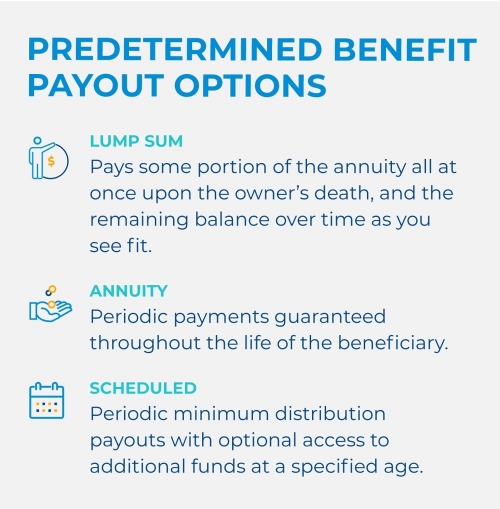All Categories
Featured
Table of Contents
This five-year general policy and 2 adhering to exceptions apply just when the owner's fatality activates the payout. Annuitant-driven payments are discussed below. The very first exception to the basic five-year guideline for private recipients is to accept the death benefit over a longer duration, not to surpass the anticipated lifetime of the recipient.
If the beneficiary elects to take the survivor benefit in this method, the advantages are taxed like any kind of other annuity settlements: partly as tax-free return of principal and partially gross income. The exclusion proportion is found by utilizing the departed contractholder's price basis and the expected payments based upon the beneficiary's life span (of shorter period, if that is what the beneficiary picks).
In this technique, in some cases called a "stretch annuity", the recipient takes a withdrawal annually-- the required quantity of yearly's withdrawal is based upon the exact same tables made use of to determine the required distributions from an IRA. There are 2 benefits to this technique. One, the account is not annuitized so the beneficiary keeps control over the cash worth in the contract.
The 2nd exemption to the five-year rule is available only to a making it through partner. If the marked recipient is the contractholder's partner, the partner might elect to "tip right into the footwear" of the decedent. Effectively, the partner is treated as if she or he were the proprietor of the annuity from its beginning.
Tax rules for inherited Annuity Cash Value
Please note this uses only if the spouse is called as a "marked recipient"; it is not available, for circumstances, if a trust fund is the beneficiary and the spouse is the trustee. The basic five-year guideline and the 2 exemptions just use to owner-driven annuities, not annuitant-driven contracts. Annuitant-driven agreements will certainly pay death benefits when the annuitant dies.

For purposes of this discussion, assume that the annuitant and the proprietor are various - Annuity rates. If the contract is annuitant-driven and the annuitant dies, the death activates the death benefits and the recipient has 60 days to decide just how to take the survivor benefit based on the terms of the annuity agreement
Additionally note that the option of a spouse to "step into the footwear" of the owner will not be available-- that exemption uses only when the owner has actually passed away however the owner didn't die in the circumstances, the annuitant did. Lastly, if the recipient is under age 59, the "death" exception to avoid the 10% charge will certainly not use to a premature circulation again, because that is readily available only on the fatality of the contractholder (not the death of the annuitant).
Lots of annuity firms have internal underwriting policies that refuse to provide contracts that name a different proprietor and annuitant. (There might be odd circumstances in which an annuitant-driven contract meets a customers one-of-a-kind requirements, yet much more frequently than not the tax downsides will exceed the advantages - Annuity income riders.) Jointly-owned annuities may pose comparable issues-- or at the very least they may not offer the estate planning function that other jointly-held assets do
Consequently, the death advantages have to be paid within 5 years of the initial owner's death, or subject to both exemptions (annuitization or spousal continuance). If an annuity is held collectively between an other half and other half it would appear that if one were to die, the other could merely proceed ownership under the spousal continuance exception.
Presume that the partner and partner called their child as beneficiary of their jointly-owned annuity. Upon the fatality of either proprietor, the business has to pay the death benefits to the son, who is the beneficiary, not the enduring spouse and this would probably beat the proprietor's intents. Was hoping there might be a mechanism like establishing up a recipient IRA, yet looks like they is not the instance when the estate is setup as a recipient.

That does not determine the sort of account holding the acquired annuity. If the annuity remained in an inherited IRA annuity, you as administrator must have the ability to assign the inherited IRA annuities out of the estate to inherited IRAs for each and every estate recipient. This transfer is not a taxable event.
Any circulations made from inherited IRAs after job are taxable to the recipient that got them at their common income tax obligation price for the year of distributions. If the inherited annuities were not in an Individual retirement account at her fatality, then there is no way to do a direct rollover into an inherited Individual retirement account for either the estate or the estate beneficiaries.
If that occurs, you can still pass the distribution via the estate to the private estate recipients. The earnings tax obligation return for the estate (Type 1041) might include Type K-1, passing the revenue from the estate to the estate beneficiaries to be strained at their private tax rates instead of the much greater estate revenue tax obligation prices.
How are Flexible Premium Annuities taxed when inherited

: We will certainly produce a strategy that includes the most effective products and functions, such as enhanced death advantages, premium rewards, and long-term life insurance.: Obtain a customized method created to optimize your estate's worth and lessen tax obligation liabilities.: Implement the picked technique and get ongoing support.: We will aid you with setting up the annuities and life insurance policy plans, supplying continual guidance to make certain the strategy stays efficient.
Nevertheless, should the inheritance be considered a revenue connected to a decedent, after that taxes may apply. Typically speaking, no. With exception to pension (such as a 401(k), 403(b), or individual retirement account), life insurance proceeds, and savings bond interest, the recipient generally will not have to bear any type of revenue tax obligation on their acquired wide range.
The quantity one can inherit from a trust without paying tax obligations depends on numerous aspects. Individual states may have their own estate tax guidelines.

His mission is to simplify retired life planning and insurance policy, making certain that customers comprehend their choices and protect the most effective coverage at unequalled rates. Shawn is the creator of The Annuity Professional, an independent on the internet insurance coverage company servicing consumers across the USA. With this system, he and his group purpose to eliminate the guesswork in retirement planning by assisting individuals locate the ideal insurance protection at one of the most competitive rates.
Table of Contents
Latest Posts
Exploring the Basics of Retirement Options Key Insights on Your Financial Future Breaking Down the Basics of Investment Plans Features of Smart Investment Choices Why Choosing the Right Financial Stra
Breaking Down Your Investment Choices A Comprehensive Guide to Investment Choices What Is Fixed Index Annuity Vs Variable Annuities? Pros and Cons of Various Financial Options Why Choosing the Right F
Breaking Down Your Investment Choices Everything You Need to Know About Financial Strategies Breaking Down the Basics of Investment Plans Pros and Cons of Variable Annuities Vs Fixed Annuities Why Cho
More
Latest Posts